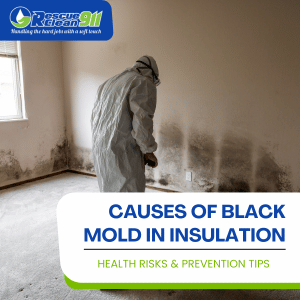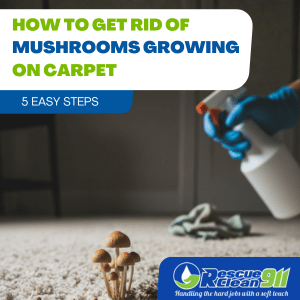If you’ve ever noticed dark patches growing on your tiles or shower curtain, you might be asking yourself: Can black mold in the shower be dangerous?
The average shower is the perfect location for mold to grow. Bathrooms are often warm, usually have low light conditions, and have a plentiful supply of moisture from showers and humidity. This means mold can thrive in most showers.
But seeing colorful mold grow along the grout and tiles of your shower is far from relaxing, especially since much of this mold is black, automatically triggering worries that you have a dangerous black mold infestation growing in your shower.
These are some of the potential dangers of shower mold and how you can keep your bathroom clean and healthy. The truth is, bathrooms are one of the most common places for mold growth, and understanding the risks is essential for protecting both your human health and your home.
Can Black Mold in the Shower Be Dangerous? Understanding the Risks
Bathrooms provide the perfect environment for mold to thrive. Warm temperatures, constant moisture, and poor ventilation create ideal conditions for shower mold.
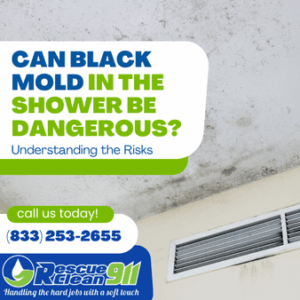 The most notorious type is Stachybotrys chartarum, commonly called black mold, which can produce mold toxins known to affect human health.
The most notorious type is Stachybotrys chartarum, commonly called black mold, which can produce mold toxins known to affect human health.
Even if your black mold growth isn’t toxic, mold spores can trigger allergy symptoms, worsen respiratory conditions, and aggravate health problems in people with weakened immune systems. Severe black mold exposure can cause:
Persistent sneezing, runny nose, and congestion
Headaches and fatigue
Fungal infections in severe cases
Aggravated asthma or other respiratory diseases
Children, elderly individuals, and people with a weakened immune system are particularly susceptible. Clinical reviews from the National Institute of Environmental Health Sciences confirm that even small amounts of mold in the shower can contribute to health risks if left untreated.
What Causes Shower Mold?
Understanding mold basics helps prevent it. Mold in your shower grows when mold spores land on surfaces that are damp and provide a food source, such as soap scum, dust, or paper products. Mold thrives under certain conditions:
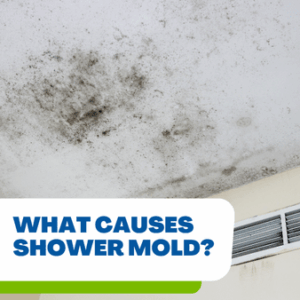 Moisture Buildup
Moisture Buildup
Excess water from hot showers, water leaks, or constant moisture on tiles and walls creates an ideal habitat for mold growth. Even minor leaks behind shower walls or in the shower area can lead to black mold growth over time.
Poor Ventilation
Bathrooms without fans or windows allow moisture buildup and indoor air stagnation, creating a breeding ground for shower mold. Ensuring adequate ventilation is one of the most effective preventive measures to reduce mold growth.
Damaged Surfaces
Loose grout, cracked tiles, or ceiling tiles damaged by water can harbor mold spores out of sight, making mold removal more difficult and increasing the chance that black mold dangerous patches may develop.
Lack of Sunlight
Mold prefers dark environments. Without proper lighting, bathrooms become perfect environments for shower black mold to thrive, potentially affecting family members who use the bathroom regularly.
Discover the risks, health concerns, and necessary steps to take if mold is found during a home inspection.
Health Impacts of Black Mold Exposure
Exposure to black mold in your shower can affect your health in multiple ways. While not every case is severe, ignoring mold growing in damp areas can lead to long-term health problems.
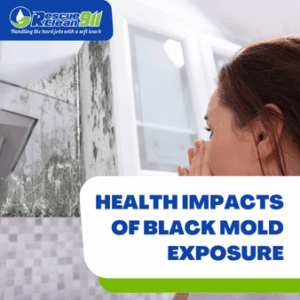 Allergy Symptoms
Allergy Symptoms
Mold spores are a leading cause of indoor allergies. Symptoms may include:
Sneezing, runny nose, or congestion
Itchy or watery eyes
Headaches or fatigue
Skin irritation or allergic reactions
Respiratory Problems
Black mold exposure can exacerbate respiratory conditions, including asthma, bronchitis, or other respiratory diseases. In severe cases, prolonged exposure to mold toxins may lead to lung inflammation.
Effects on the Immune System
People with a weakened immune system are more susceptible to fungal infections caused by shower mold. Those undergoing chemotherapy, transplant patients, or individuals with chronic illnesses should take extra precautions.
Long-Term Health Concerns
Clinical reviews from the National Institute of Environmental Health Sciences and other environmental health sciences studies show that prolonged black mold exposure can contribute to health issues, especially in sensitive individuals.
How to Identify Black Mold in Your Shower
Shower black mold typically appears as black or dark green spots. Common locations include:
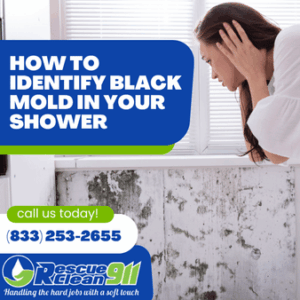 Along shower walls and floors
Along shower walls and floorsAround the shower curtain or tracks
Behind ceiling tiles or in corners
On loose grout or cracked tiles
Signs that mold may be growing include:
Persistent musty odors
Visible black mold growth
Stains that return quickly after cleaning
While lab testing is the only way to confirm Stachybotrys chartarum, treating all shower mold as potentially dangerous is the safest approach.
Learn how water damage leads to mold growth, why it occurs, and what you can do to prevent and remove it.
How to Remove Mold from Your Shower
Small areas of shower mold can be treated at home:
Cleaning Solutions – Use a commercial mold removal product or a bleach-water solution (1 part bleach to 2 parts water).
Scrubbing – Apply with a bristled brush or toothbrush for tight areas.
Drying – Thoroughly dry surfaces afterward to prevent mold from growing back.
For large or recurring infestations, professional black mold removal is recommended. Experts ensure mold spores do not spread and treat hidden areas behind shower walls, ceiling tiles, or under tiles.
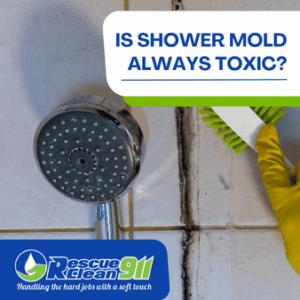 Is Shower Mold Always Toxic?
Is Shower Mold Always Toxic?
Many people panic when they see black mold in their shower, fearing the notorious toxic variety. However, shower mold can be black, pink, red, green, or other colors.
While all molds can produce mycotoxins, which may cause health issues if ingested or inhaled, shower mold rarely reaches dangerous levels. The typical bathroom environment usually doesn’t support significant toxin production, making serious long-term health effects unlikely.
Can You Get Sick From Shower Mold?
Even if toxic mold isn’t a major concern in showers, mold spores can trigger allergy symptoms, such as a runny nose, sneezing, headaches, drowsiness, and congestion.
These issues can worsen if the shower mold continues to grow. Beyond health risks, unchecked mold can damage drywall, grout, and tiles, making prompt cleaning essential for both human health and home maintenance.
Find out how to safely identify, remove, and prevent mushrooms growing from your ceiling to protect your home’s structure and indoor air quality.
How to Prevent Shower Mold
Preventing mold growth requires knowing what causes mold to grow in the first place. Mold is actually a type of fungi that floats through the air in spores. When one of these spores lands on a good growing environment, it will start to produce more spores and cover the surface.
The ideal habitat for mold is one that is:
Warm – Mold grows best between 60 and 80 degrees Fahrenheit.
Dark – Direct sunlight will kill mold, although not mildew.
Has Food – Some natural material is necessary for mold, but this can often be found in the air in a bathroom.
Moisture – Mold needs near constant moisture to grow.
When you can take steps in your bathroom to remove some of these components, you significantly decrease the risk that shower mold will start to grow.
 Keep Your Bathroom Dry & Well-Ventilated
Keep Your Bathroom Dry & Well-Ventilated
Ventilating your bathroom with a fan or open window prevents excess moisture from building up during a hot shower and dries the room out more quickly afterward. This prevents water from collecting on ceilings, walls, and floors, and also keeps the temperature of the room down to make the space less ideal for mold.
Use a Shower Curtain
A shower curtain keeps water in the tub and not on the floors. A lot of water on your bathroom floors can seep beneath the tile and cause mold to grow underneath without you realizing it. You will want to keep the shower curtain open after bathing, however, to let the interior of the shower dry out.
Clean It Up Right Away
After your shower, remove excess water from doors and shower walls. Also, use a towel to wipe up any water that may have splashed onto the floor as soon as you get out of the shower. Stepping out onto a bathmat will also prevent water from puddling on the floor.
Products to Prevent Shower Mold
There are a few products around your bathroom that can also help prevent black mold from growing in your shower. All these are readily available online or in local stores and include:
Shower Rack – Putting all your toiletries on a rack can prevent them from collecting water underneath and growing mold.
Hooks – Likewise, if you have loofahs or washcloths, hang them on hooks to let them dry completely after a shower.
Squeegee – A shower squeegee makes it easy to wipe down tile and walls.
After Shower Sprays – You can spray specially made after-shower sprays onto the walls and floor of your shower to prevent mold from growing.
Dehumidifiers – If your bathroom does not have a fan or windows, a dehumidifier can also help to reduce moisture in the room while you are showering.
Along with the other strategies to keep your bathroom clean and dry, investing in a few of these products provides additional protection against harmful mold in your bathroom.
Related article: How To Get Rid of Mushrooms Growing on Carpet
Products to Help Prevent Black Mold
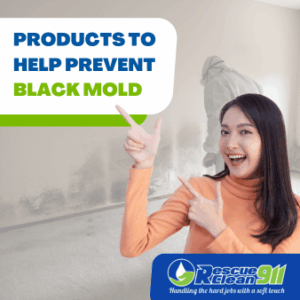 Shower Racks – Keep toiletries dry and prevent mold from growing underneath.
Shower Racks – Keep toiletries dry and prevent mold from growing underneath.Squeegees – Remove water from shower walls after each use.
After-Shower Sprays – Specifically designed to prevent black mold growth.
Dehumidifiers – Reduce humidity in bathrooms with poor airflow.
These products, combined with proper cleaning, keep your bathroom safe and mold-free.
Allergy Management
For individuals sensitive to mold:
Consider a skin prick test or blood test to check for mold allergies.
Use allergy medications for common symptoms of black mold, like sneezing and a runny nose.
Severe cases may require allergy shots.
Prompt mold removal not only improves bathroom hygiene but also reduces health risks.
Black Mold Myths vs Reality
Myth: All black mold is toxic.
Reality: Not all shower mold is toxic black mold, but all can trigger allergic reactions.Myth: Small patches are harmless.
Reality: Even small black mold growth can release mold spores and affect human health.Myth: DIY removal is always enough.
Reality: DIY works for small areas, but professional black mold removal is safer for severe infestations.
FAQs About Shower Mold
No, shower mold can be black, green, pink, or red. All can pose health risks.
Mold can start growing within 24–48 hours in constant moisture conditions.
Yes, kids are more susceptible to allergy symptoms and respiratory problems.
Yes, prolonged exposure can worsen respiratory conditions like asthma.
They use containment, specialized cleaners, and repair damaged tiles or grout.
Regular cleaning, good ventilation, after-shower sprays, and addressing water leaks promptly.
Yes, hidden mold can grow behind tiles, loose grout, or ceiling tiles.
Rarely, but it can cause serious health issues in immunocompromised individuals.
Black mold in a shower is rarely highly toxic, but prolonged exposure can trigger allergies and respiratory problems.
Monthly inspections are recommended to catch early black mold growth.
The only way to confirm if black mold is dangerous is through lab testing, but all mold should be treated as potentially harmful.
Final Thoughts
While mold in the shower is common, black mold exposure can lead to health issues, particularly for those with a weakened immune system. By implementing preventive routines, maintaining good ventilation, and conducting regular mold removal, you can safeguard your human health.
Ultimately, by staying vigilant and proactive, you can enjoy a cleaner, healthier bathroom environment and minimize the risk of serious health effects, making it easier to answer the important question: Can black mold in the shower be dangerous?

